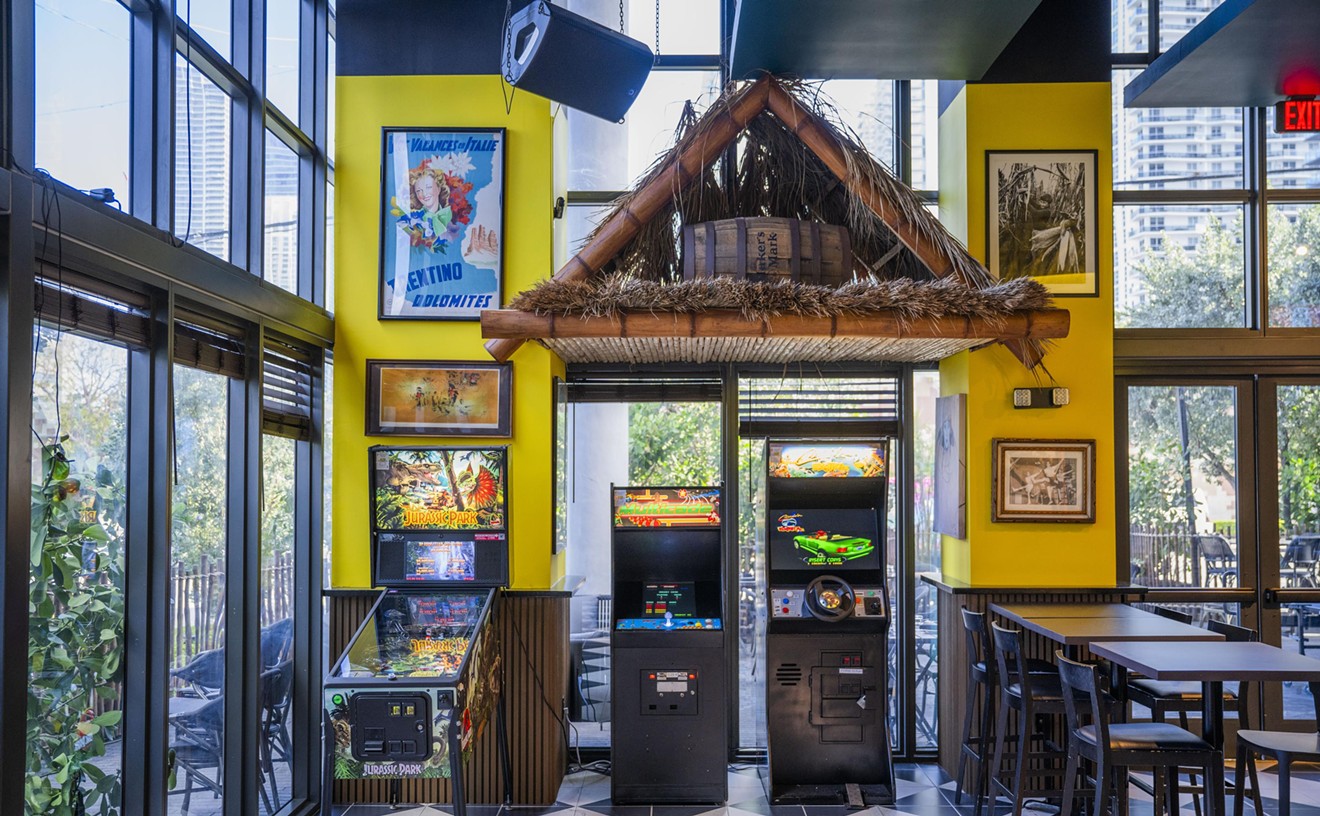The newest of these "new-style" joints to open is SushiSamba Dromo, in a Lincoln Road space that was, when I moved to SoBe in the early Nineties, the very minimalist Lyon Freres charcuterie. Not that you could even vaguely imagine that; designer Nancy Mah's red-lit, curvaceous, sexily South American hot new interior is total nightclub glamour. Fortunately, though, the food is not typical nightclub stuff. Like its New York parent restaurant, SushiSamba's food combines elements from Japan with those of two Latin nations with large Japanese populations, Peru and Brazil (although obvious Brazilian elements are really reflected only in the menu's relatively small selection of cooked entrées). Take your tip from the not just beautiful but big and buzzing central sushi/ceviche bar: SushiSamba Dromo is not just another pretty face.
In fact I experienced only two negatives marring my dining experiences at SushiSamba, first being a confusingly vague menu. Like most frequent restaurantgoers, I am over terminally trendy menus that overdescribe every last spice in a dish by name, grower's name, street address, pedigree, and education. But SushiSamba's menu neglects some descriptions vital to making food choices, particularly for people not entirely familiar with Brazilian, Peruvian, or Japanese ingredients. For example, while the eatery's ceviches and tiraditos are extensive, there's no explanation of how the two specialties differ. Sawagani are described only as "Japanese river crabs," which could easily leave more-squeamish diners floored when confronted with a ten-buck plateful of thumbnail-size whole creatures strongly resembling hard-shelled spiders (and meant to be crunched down claws and all). What are the six seaweeds in six seaweed salad? The vegetables in the Latino vegetable tempura? What's a kabocha squash? How hot is a shisito pepper? It was fortunate that our waiter, Sammy, was a most accommodating interpreter, even fetching a manager on two occasions when she didn't have answers to the many inquiries.
Sopa de kabocha proved to be a spectacularly subtle dish whose creaminess came from the vegetable rather than added fats. Kabocha, new to the United States, is considered in Asia the ultimate in squash sweetness and natural richness, like a lighter pumpkin or a fiber-free acorn squash. And SushiSamba's soup featured just enough ginger to perk up the kabocha's velvety smoothness, enough pumpkin seeds to accentuate the squash's nuttiness, and enough stone crab to make my table feel as though we were living in luxury.
Conchitas gratinadas, a minicasserole, centered on tender scallops quick-seared to caramelization, in a sauce that was pleasantly brandied (from pisco), slightly hot (from Peru's classic aji amarillo peppers), and complexly creamy (from sea urchin).
Chicharron de calamar wasn't the tenderest squid I've ever had. But the blue cornmeal crust (cornmeal has historically been important in Brazilian cuisine) was nearly greaseless. And the chili-spiked tamarind sauce, subtly sweet yet tangy, will make you never want to see another plate of in-yer-face marinara-sauce calamari again.
Six seaweed salad featured a flopsy brown seaweed, a nearly see-through gelatinous weed, a perky spiked dark red weed, and a delicately crisp knock-out pink number, in addition to the usual green/clear wakame and black hijiki salads. Not just the variety but a cucumber/miso sesame dressing minus standard sesame overkill made this appetizer heads and shoulders superior to other seaweed dishes.
Superior saucing also made shrimp and Latino vegetable tempura a winner; the dipping potion, though as thin in texture, tasted far more substantially savory than standard fishy Japanese tempura broth.
One difference between SushiSamba and its NYC parent is its use of local ingredients. Stone crab was one. Blue runner was another. Ever hear of blue runner? Neither had I, even though I fish. But as explained by a good-natured manager Sammy dragged over, it's a small member of the jack family that tastes great yet is seldom eaten. Our sushi was fresh, challengingly chewy, and cleanly briny with no fishiness -- making it more annoying yet that most of our other local sushi bars serve few local fish except grouper and yellowtail.
Not that all the usual sushi suspects aren't available here. They are, some in classic form, others with the adds that have become standard stuff in new-style sushi bars, like jalapeño. I'd recommend one of the seven more creative SushiSamba rolls, like the crunchy spicy tuna roll, which could become seriously addictive: A cluster of airy, ultrathin deep-fried flakes gives the roll all the sinful succulence of a usual cooked shrimp or fish tempura roll but with the delightfully unexpected shock of velvety raw tuna. A mildly spicy mayo adds enough complex flavor and creaminess to render soy dunking unnecessary.
As tasty as the tuna roll was, though, SushiSamba's most impressive tour de force was a huge mixed ceviche/tiradito assortment (basically the latter is onion-free, and tiradito's fish generally is thin-sliced, like Japanese usuzukuri, while ceviche comes in small bits). But both traditionally consist of some white-fleshed fish, marinated in lemon and hot chili: very tasty, very simple. SushiSamba's five ceviches and five tiraditos -- which are sauced on the spot rather than long-marinated, making the fish's texture less tough -- are anything but simple, using many different sorts of fish and shellfish, with different inventive marinades on each: fluke, a traditional white fish with ponzu and grapefruit; a truly cooked, rather than just citrus-"cooked" toro fatty tuna with lemon, lime, and red daikon radish; a carpacciolike baby yellowtail with black truffle oil; a salmon tiradito with smooth strawberry/key lime sauce (and, actually, a cevichelike red onion garnish -- rules are made to be broken); and so on.
This gorgeous assortment would make a perfect hors d'oeuvres platter for holiday parties -- if SushiSamba Dromo allowed take-out. But it doesn't, as I discovered to my dismay one evening when two hungry guests turned up unexpectedly for cocktails, and I ran out to SSD for nibbles. "The reason is freshness, because we do so much raw fish. With take-away the chef cannot control how quickly the food gets eaten," explained an adamant employee, unmoved by pleas that my home was a mere five minutes away.
To be fair Nobu also has a rigid rule against take-out. The superb Shoji Sushi does not. And Shoji's raw fish is at least as exemplary as SushiSamba's (or Nobu's). So I don't think we're talking about food freshness here. I think we're talking about food fascism -- shouldn't we get to make our own choices, rather than having authority figures (political, religious, or, yes, even culinary) make our choices for us?
No one can prevent eat-in diners from taking leftovers home, and I assure you that despite the lack of Dromo's sexy décor, the salmon ceviche with Dijon miso seemed just as seductively sweet and tart half an hour later on my back porch.










